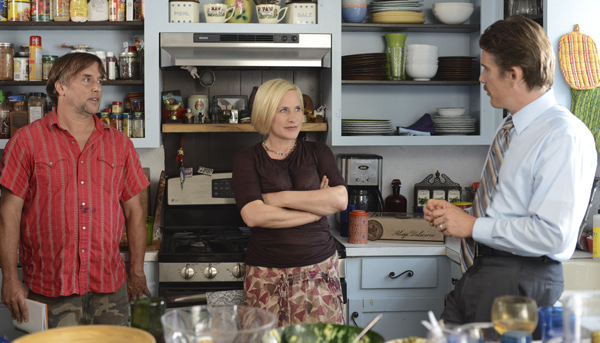
From left, Richard Linklater, Patricia Arquette, and Ethan Hawke on the set of Boyhood (Matt Lankes/IFC Films)
What a documentary such as Richard Linklater: Dream Is Destiny accomplishes is to remind us how easy it is to take an artist for granted. We may not do this all the time, and, of course, reputation can factor into our perceptions. However, as the subject of a film about how he’s developed as a storyteller over the past 25 years (or further back if you include his experimental work in the 1980s), Linklater proves to be the kind of humble, down-to-earth yet determined-to-do-it-his-way presence that is uncommon in today’s mass market world of movies. He simply wants to make his films any way he can, whether it’s through Hollywood or forging ahead on his own.
Linklater at first wanted to be a baseball player, and he tried to go that route while attending college in Texas (this bit of his biography informed his recent comedy Everybody Wants Some!!), but due to an injury, he had to drop out of that path. Due to seeing a lot of films while on leave from working on an oil rig during the early ’80s, he became enamored with cinema’s possibilities. More than that, he was impressed by those who carved their own paths outside the studio system with little money but boundless creativity.
After a couple of oddball experiments in which he learned how to express visual ideas (if you’ve ever seen “Woodchuck” or “It’s Impossible to Learn to Plow by Reading Books,” both among the special features of the Slacker Criterion edition, you’ll see how those turned out), he set out to make Slacker. The film depicts a day in the life of Austin and those out on its fringes and spends a little stretch of time with one character before going off with another. A fascinating point is that Linklater wasn’t necessarily setting out to make some big statement or crash through the indie movement—at best, maybe he thought he would sell some videos through an art-house film magazine or sell Slacker to European TV, that kind of ideal. Yet he ended up thrust into something that would launch a number of careers (such as for the cast of Dazed and Confused). In other words, he was in the right place at the right time to be making something with a unique vision.
The documentary doesn’t exactly bring to light any wild new revelations. If you’ve seen interviews of Linklater already, it won’t tell you much more about his sense of self or how he sees his films or his place in the industry. He has a slightly laid-back way of speaking, sort of an anti-Tarantino-level of oratory command, and that’s more than fine. He speaks about his work, the struggles to get certain films made, and their troubled releases—both Dazed and Confused and The Newton Boys were dumped by the studios that financed them—in such a way that I never tire of hearing about them.
If you’re interested in hearing an intelligent, passionate filmmaker talk about his process with other talking heads (collaborators such as author/former film rep John Pierson, Ethan Hawke, Julie Delpy, producers, and editors and so on) giving praise to his career and accomplishments (unconventional as some of them may be), this film should make for a captivating viewing experience.
Stylistically, it’s linear, which is perhaps the best way to depict a man who makes such idiosyncratic work (Waking Life and Tape in one year, School of Rock in another, followed by Me and Orson Welles, Boyhood, and the “Before” trilogy). Despite attaining mainstream acclaim and accolades, what’s perhaps most surprising is that Linklater turns out to be genuinely humble about it all—he’s simply a guy who loves his art and tries to practice it in ways he finds compelling. If nothing else, a movie like this might get people to see more of his films outside of just Boyhood or Dazed, and that would be a good thing.
















Leave A Comment